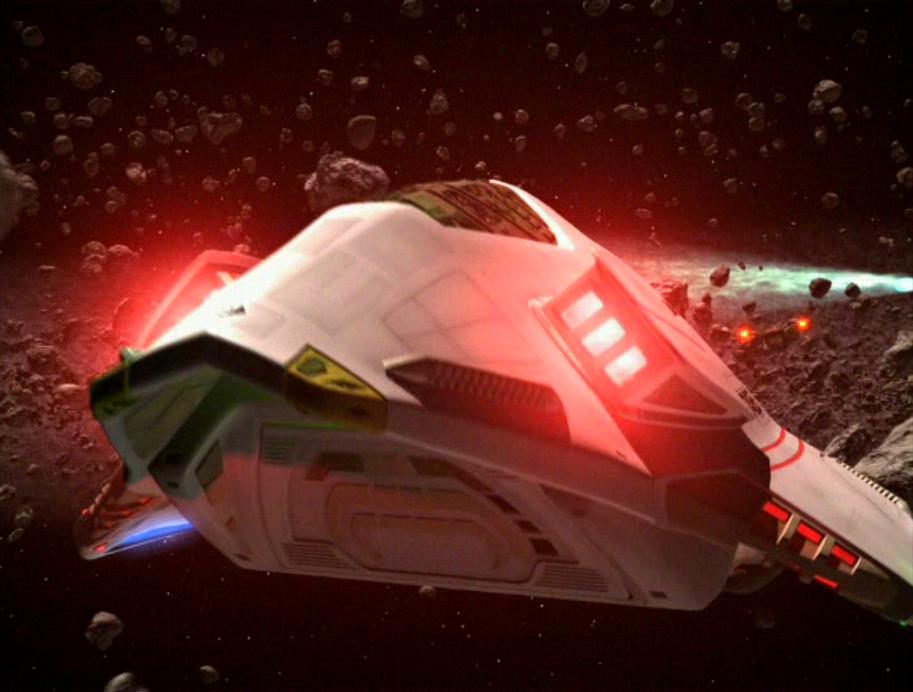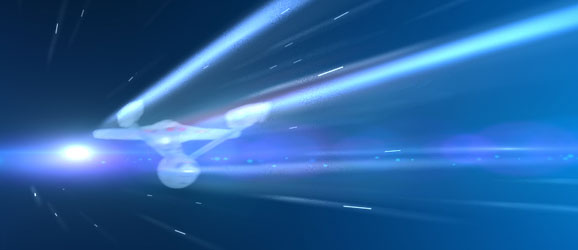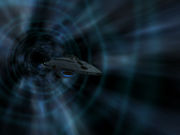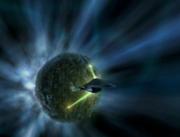Propulsion
There are two types of propulsion used in Starfleet. This page is a basic overview of each type of propulsion.
Impulse Drive 
Impulse drive is the standard manuevering thrusters. This is for travelling slower than light and is mainly used within systems or when a Starship is in combat. Impulse drive is possible due to special reactors which control thruster style engines. These engines are able to propel a Starship through space easily, however they are not powerful enough to cause a Starship to travel between star systems. Impulse Drive is the slowest of the drives that Starships have equipped yet is faster than Thrusters.
Impulse drive is also the type of propulsion that allows Starships to orbit a planet. However Impulse Drive can also be used by Smaller Vessels such as shuttles and runabouts to enter and exit a planets atmosphere. This is possible as the Impulse Drive gives out enough thrust for escape and re-entry velocities. It should be noted that the reactors that control the Impulse Drive are Fusion powered and therefore can be used as a power source for Starship and Shuttle systems.
Warp Drive
 Warp Drive is the fastest type of propulsion that is equipped on a Starship. Warp Drive allows for a Starship to traverse deep space and travel to different star systems. Warp Drive is possible through the use of Matter and Anti-Matter injection technology. Anti-Matter and Matter collide within a controlled environment providing an huge amount of energy. This energy is channeled into specially built Nacelles. The Nacelles contain a series of coils, these coils create a Subspace Warp Field.
Warp Drive is the fastest type of propulsion that is equipped on a Starship. Warp Drive allows for a Starship to traverse deep space and travel to different star systems. Warp Drive is possible through the use of Matter and Anti-Matter injection technology. Anti-Matter and Matter collide within a controlled environment providing an huge amount of energy. This energy is channeled into specially built Nacelles. The Nacelles contain a series of coils, these coils create a Subspace Warp Field.
With the creation of a Subspace Warp Field a Starship can 'bend' space around it by encasing itself in a bubble. This allows a Starship to travel faster than light as it then enters an area of space known as "Subspace". Tremendous thrust from the Anti-Matter/Matter reaction allows the ship to travel through subspace therefore defying Einsteins theory fo Relativity. It can be argued that when a Starship is at Warp they are technically travelling through time as they are bending local space time around them.
Quantum Slipstream
Slipstream Drive is an advanced form of Propulsion first encountered by the crew of the USS Voyager. Slipstream works on the same concept as Warp Drive but is much faster and much more efficient in speeds. It works through the use of a quantum matrix which allows a starship to essentially "slip" between the fabrics of space time therefore making Warp Drive slow and insufficient in comparison. However there are problems with Slipstream as a phase variance can throw a starship out of a slipstream tunnel causing the ship to break up as internial dampners and structural integirty cannot cope with sudden decellration.
Transwarp Drive
 Transwarp Drive has been around for nearly 100 years. It was first experimented with on the USS Excelsior. However due to a failure in the drive when the Excelsior was in pursuit of the stolen USS Enterprise the project was scrapped and Starfleet haven't developed any further with the technology. However it has been established that The Borg Collective use a different type of Transwarp Drive. This is developed through a series of artificially created subspace tunnels that are constantly opened. Through the use of Transwarp Coils ships can enter these tunnels and propel themselves at extreme speeds through subspace. This is possible as there is no need to generate a subspace field as it is constant therefore power can be transfered to travel, this is a fast and highly efficient way of travel which is most likely the reason The Borg uses this type of propulsion.
Transwarp Drive has been around for nearly 100 years. It was first experimented with on the USS Excelsior. However due to a failure in the drive when the Excelsior was in pursuit of the stolen USS Enterprise the project was scrapped and Starfleet haven't developed any further with the technology. However it has been established that The Borg Collective use a different type of Transwarp Drive. This is developed through a series of artificially created subspace tunnels that are constantly opened. Through the use of Transwarp Coils ships can enter these tunnels and propel themselves at extreme speeds through subspace. This is possible as there is no need to generate a subspace field as it is constant therefore power can be transfered to travel, this is a fast and highly efficient way of travel which is most likely the reason The Borg uses this type of propulsion.
Articles on Propulsion
Advanced Warp Drive Theory - Ritsu Tainaka